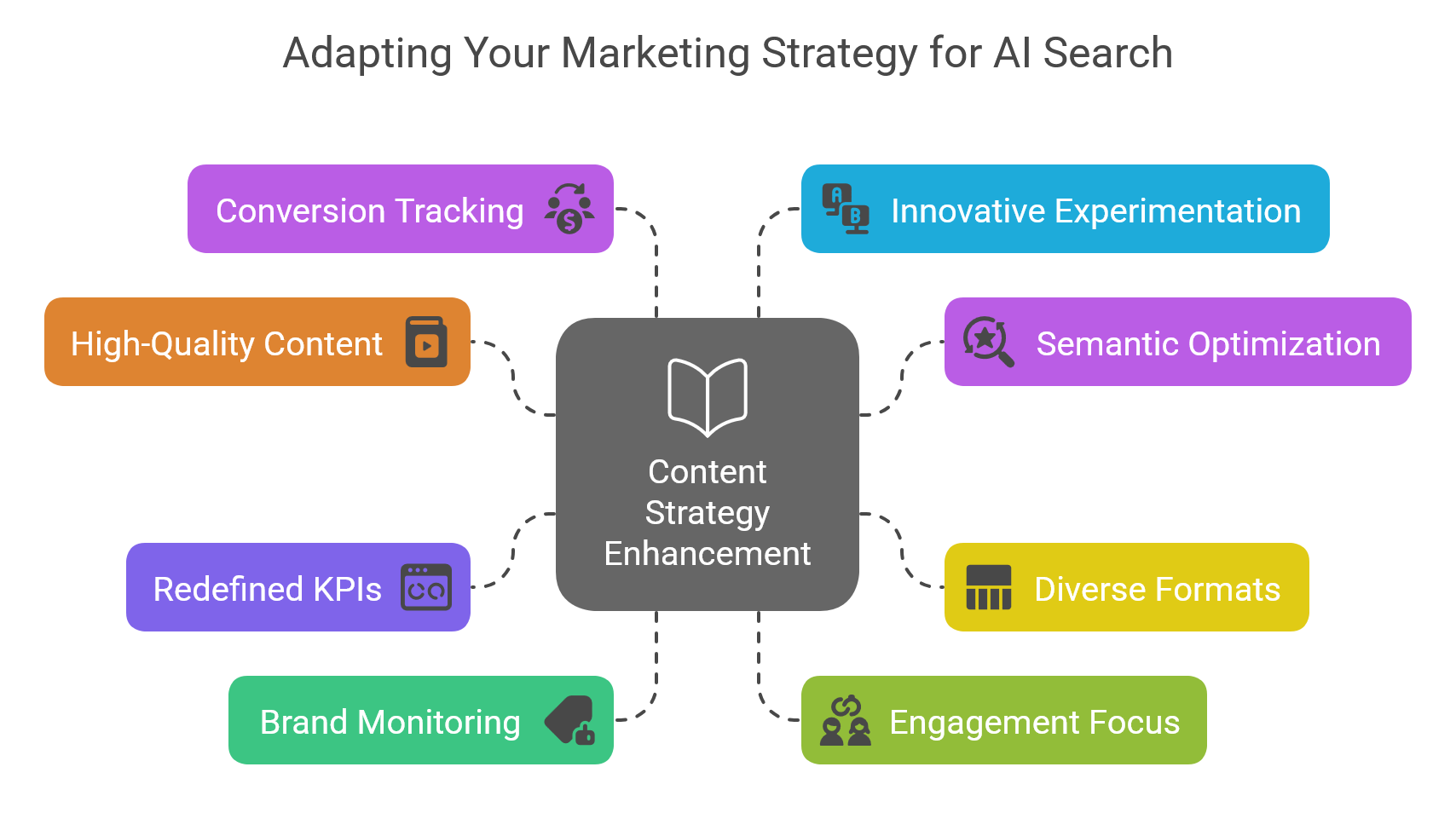For much of the web’s history, the biggest marker of online success was the view.
Did web surfers see your brand on the first page of Google? If so, did they click through to see your site and learn more?
For many SEOs and content marketers—even the top SEO companies out there—that meant a single-minded focus on organic traffic, page views, and session duration. These were clear, easy to understand numbers that corresponded directly to that goal of being seen, and for a long time they worked just fine.
But that was before the rise of AI-powered search and the proliferation of zero-click searches. Now, understanding your site’s online success (or failure) means deeper analysis and a whole new raft of metrics tied more closely to things that actually matter to business. Here’s what you need to know.
Why AI is Changing Your Marketing Metrics
You already know the way consumers seek and find information online is undergoing a seismic shift thanks to AI search, but you might not appreciate the scale or speed at which it’s happening.
AI search engines and AI-driven summaries on results pages are becoming increasingly sophisticated, providing direct answers for more and more queries, and negating the need for users to click through to individual websites. Bain & Company's research indicates that 80% of consumers now rely on these "zero-click" results at least 40% of the time. This shift is substantial, with some estimates suggesting up to a 30% reduction in organic web traffic as a direct consequence.
Users are increasingly getting their informational needs met directly on the search results page, with about 60% of these searches now ending without a click.

Even those skeptical of generative AI are finding that their search queries are often answered without needing to visit another site. Platforms like ChatGPT have seen exponential growth, indicating a clear user preference for immediate, summarized information. These LLMs are encroaching on traditional search use cases as their own search capabilities improve, with a significant portion of users now using them for research, news summaries, and even shopping recommendations.
The implications for traditional metrics like traffic, clicks, views, and visits are profound. While these numbers once provided a clear indication of your brand’s reach, they are becoming increasingly disconnected from actual user engagement and business outcomes in this new era of search. So what should you be tracking instead?
The New Web Metrics to Track
As the playing field evolves, business and marketing leaders need to pivot their focus to metrics that reflect deeper engagement and tangible business value. Those generally fall into three buckets:
- Engagement metrics
- Lead and conversion metrics
- Visibility metrics

Engagement Metrics
These metrics offer a picture of how effectively your brand is connecting with audiences, even if they aren’t immediately clicking through to your website via search. Engagement metrics include things like:
- Social Media Interactions: Likes, shares, comments, and mentions that indicate resonance with your content.
- Email Engagement: Open rates, click-through rates, and forward rates show whether customers are finding value in your email communications.
- Engagement Rate: The percentage of “engaged” sessions among people who make it to your website, indicating that your content and user experience is effective.
- Return Visits & Time on Site: These metrics offer insights into the quality and depth of engagement for users on your site. This approach focuses on the behavior of users within your ecosystem, rather than just attracting a lot of eyeballs.
- Brand Mentions & Sentiment: Tracking how your brand is being discussed online, both positively and negatively, provides a more holistic understanding of your brand's influence.
Conversion Metrics
Ultimately, the metrics that directly tie to your business objectives are paramount. Conversion metrics demonstrate the impact of your online efforts on your bottom line:
- Leads Generated: The number of qualified prospects you are attracting through your content and online presence. This can be measured by time period, source, channel, campaign, or even different points in the user journey.
- Downloads & Sign-Ups: Actions that indicate a user is moving further down your marketing funnel and engaging more deeply with your offerings.
- Customer Lifetime Value (CLV): Understanding the long-term worth of your customers, which is influenced by the quality of your engagement and the strength of your relationships.
Lead quality is another increasingly important metric in this area. Attracting a large number of leads is less valuable than generating qualified leads that are more likely to convert into customers. Focus on research and data that helps you understand the profile and the intent of the leads you’re generating, to make sure it aligns with your targets.
Visibility Metrics
In a world of zero-click search, visibility metrics take on new significance. Even without direct clicks, appearing in AI overviews, featured snippets, and knowledge panels enhances brand awareness and establishes you as a trusted source of information. Visibility metrics you’ll want to track include.
- Search Impressions: How often your content appears in organic search results, even if it doesn't get clicked. This is a great proxy for your brand’s visibility—does Google see you as an authority on the topic?
- Search Position: Where your content ranks in search results, as higher positions increase the likelihood of being included in AI summaries and catching the eye of web surfers looking to go deeper on the topic.
- Presence in AI Overviews & Featured Snippets: Leading SEO platforms can now track which pieces of your content are being featured in AI summaries, Google’s featured snippets, and more.
Need help understanding how to capture or bring all of these different metrics together? Your friendly local marketing agency can help! Adam Moore explains how in the video below:
Your New Digital Marketing Gameplan
Adapting your online marketing strategy to the new world of AI search requires a shift in your testing and SEO strategies. Here are some key considerations:
- Prioritize creating high-quality, authoritative content. Focus on providing comprehensive, accurate, and insightful information that aims to be the best answer to users’ queries. Include expert quotes, original data, and clear explanations. This will increase your chances of being seen as an authority on a search topic and getting pulled into an AI overview.
- Optimize for semantic search and AI readability. Adapt your content for semantic search by targeting long-tail keywords that match your user’s intent for a specific search in time. Focus your keyword research on understanding why users are searching for specific terms, and create content specific to that motivation.
- Diversify your content formats. Go beyond text-based content. Incorporate video, interactive elements, and infographics to enhance visibility in generative AI search results.
- Redefine your key performance indicators (KPIs). Shift away from a sole focus on click-based metrics and start measuring search impressions, AI reach, and engagement on your own platforms. Work to develop a more holistic understanding of how they all play together, rather than looking at each one in a silo.
- Monitor your brand's presence in AI-driven results. Track where and how your brand is being mentioned in AI overviews and featured snippets. This provides valuable insights into your brand's visibility in the zero-click landscape, even if organic clicks are falling.
- Focus on engagement within your ecosystem. Instead of trying to get more people into the ballpark, focus on selling more merchandise to the people already in the crowd. Since direct traffic from search may decline, prioritize creating compelling experiences on your website to deepen engagement with users who do land there.
- Track conversions and lead quality diligently. Ultimately, your marketing efforts should drive business results. Closely monitor your conversion rates and the quality of your lead generation efforts to understand the true impact of your strategies. Consider working with a lead generation agency if you’re not getting satisfactory results here.
- Experiment boldly with new strategies. The rules are still being written online. Embrace innovation and test different approaches to influence visibility and positioning in both traditional search engine AI overviews and newer LLM engines. The winners in this space will be those willing to take risks with their brand and positioning.

The rise of AI-powered search means we need to be measuring our marketing outcomes differently. While traditional metrics like visits and clicks are losing their relevance, new metrics focused on engagement, conversions, lead generation and visibility are taking center stage.
Our Takeaway: Adapt or Be Left Behind
The rise of AI-powered search isn't just a shift—it’s a revolution in how consumers get information and learn about brands. Marketers and business leaders who cling to outdated metrics are in for a world of disappointment—and eventually, irrelevancy—as they watch those numbers drop.
By focusing on engagement, conversion, and visibility metrics, you’ll gain a clearer picture of how your audience interacts with your brand, even in a world where search traffic alone no longer tells the whole story. The brands that win will be those that evolve their measurement strategies, optimize for AI-driven search, and prioritize meaningful engagement over empty clicks.
Now is the time to rethink your marketing scorecard. Are you tracking the right metrics for the future of digital marketing? If not, it’s time to start. Give Informatics' experts a call today!
Looking for measurable success online?
Our Digital Marketing experts can help you find the right metrics to understand your growth.

